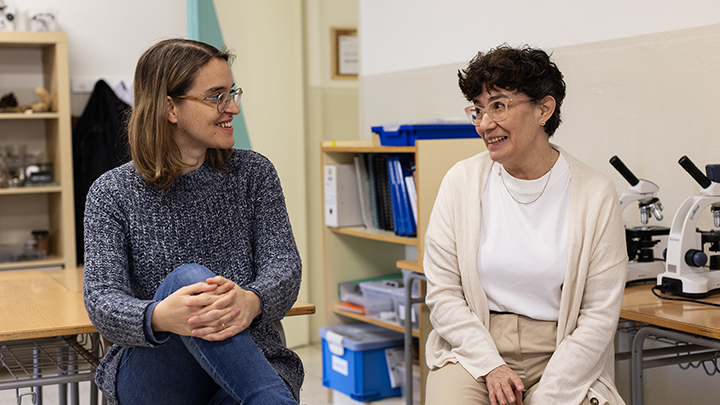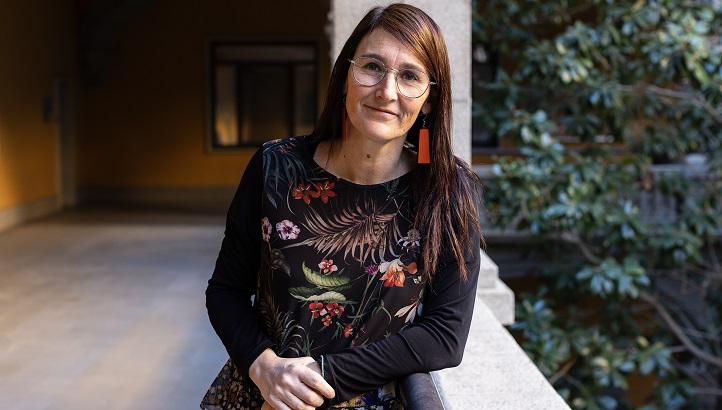Science spreads at school

News
|
Academic
|
Divulgation
|
Equality
(05/02/2024)
The lecturer of the Faculty of Physics Sònia Estradé is used to visit schools, as part of the dissemination activities the UB carries out. The teacher Maria Neira has experienced situations that result from science dissemination at primary education schools, usually with support from the University. On the occasion of the International Day of Women and Girls in Science, both talk about how to bring science closer to the children, and in particular, to the girls, with specific examples of the centre where Maria works, the Escola La Pau de Barcelona.

News
|
Academic
|
Divulgation
|
Equality
05/02/2024
The lecturer of the Faculty of Physics Sònia Estradé is used to visit schools, as part of the dissemination activities the UB carries out. The teacher Maria Neira has experienced situations that result from science dissemination at primary education schools, usually with support from the University. On the occasion of the International Day of Women and Girls in Science, both talk about how to bring science closer to the children, and in particular, to the girls, with specific examples of the centre where Maria works, the Escola La Pau de Barcelona.
“In education, it is important to teach that science is learnt from reason and emotion, by formulating questions and finding answers, applying logics, creativity and imagination, individual work and teamwork”. Words by Genina Calafell, UB lecturer of Didactics of Experimental Sciences. She also mentions the importance of “connecting science with the children’s daily life” to share this interest in science. Regarding the girls, however, there is an “identity culture” problem when approaching this. “For instance, textbooks and educational material feature only a few scientific women, and therefore girls do not have enough role models; many science-learning contexts are very male-dominated and come from a very homogeneous culture. We need more diverse contexts in which the interest in science comes from identity plurality”, notes Calafell. Sònia and Maria reflect on these issues.
Boys, girls and science
Sònia: When you visit a school for a dissemination activity, you see that when children are around six or seven years old, they already have the gender stereotypes very internalized. In a classroom, you see girls are more obedient, they behave better because it is a gender mandate. Boys take more public space. They occupy more space and they are louder. They are allowed to do so.
Maria: At school, I have seen the reality Sònia talks about, this starting point, but I have seen another final point. We carried out a project about building a laboratory at school. By the end of this project, girls saw themselves as scientists, and many of them wanted to be researchers. Also, the Committee of Memory and Gender of the Sant Martí district asked us to name a square near the school. Both boys and girls, who had visited CosmoCaixa, and specifically an activity on women and science, said: “We want the name of one of the women scientists we saw at the museum”. Now the square is called Rosalind Franklin.
Models
Maria: I wanted women scientists to visit our centre because we need female role models in the field of science. We talked to La UB Divulga and Alba Ortega Gascó, researcher from the Faculty of Biology, came to see us. Alba made the students curious, and the laboratory-building project was born after this. To conduct this activity, we talked to La UB Divulga, and we contacted the UB lecturer of Chemistry Josep Maria Fernández Novell, dean of the School of Chemists of Catalonia. Now our laboratory is named after him.
Sònia: As a researcher, when you visit a primary education school, the children want to know who you are, they want to know about you. They need to see you are not a very different person. You are someone they could meet any day and someone who works as a scientist, and that this job is fun. It is also important that they see there are many women working on science: young, older, people from other places… I could name a few, but this is not about bring more women to scientists, or more vocations, but about a better science. Currently, the system is not friendly, it is not built for many women scientists.
Boys, girls and science
Sònia: When you visit a school for a dissemination activity, you see that when children are around six or seven years old, they already have the gender stereotypes very internalized. In a classroom, you see girls are more obedient, they behave better because it is a gender mandate. Boys take more public space. They occupy more space and they are louder. They are allowed to do so.
Maria: At school, I have seen the reality Sònia talks about, this starting point, but I have seen another final point. We carried out a project about building a laboratory at school. By the end of this project, girls saw themselves as scientists, and many of them wanted to be researchers. Also, the Committee of Memory and Gender of the Sant Martí district asked us to name a square near the school. Both boys and girls, who had visited CosmoCaixa, and specifically an activity on women and science, said: “We want the name of one of the women scientists we saw at the museum”. Now the square is called Rosalind Franklin.
Models
Maria: I wanted women scientists to visit our centre because we need female role models in the field of science. We talked to La UB Divulga and Alba Ortega Gascó, researcher from the Faculty of Biology, came to see us. Alba made the students curious, and the laboratory-building project was born after this. To conduct this activity, we talked to La UB Divulga, and we contacted the UB lecturer of Chemistry Josep Maria Fernández Novell, dean of the School of Chemists of Catalonia. Now our laboratory is named after him.
Sònia: As a researcher, when you visit a primary education school, the children want to know who you are, they want to know about you. They need to see you are not a very different person. You are someone they could meet any day and someone who works as a scientist, and that this job is fun. It is also important that they see there are many women working on science: young, older, people from other places… I could name a few, but this is not about bring more women to scientists, or more vocations, but about a better science. Currently, the system is not friendly, it is not built for many women scientists.
“This is not about bring more women to scientists, or more vocations, but about a better science”.
Explaining science at school
Sònia: We need the emphasis on the public education. Your school is a great example, Maria. It is important for everyone to welcome science, everyone should see a diagram about the solar system and understand whether that is a picture or a diagram. This level of understanding and the relationship with science is important for the whole society. The, whoever is interested, do science, which is fun! The message we have to send is that science is about finding stuff, playing with expensive toys. It is about finding out, playing, and this is easy to explain to kids.
Maria: There are many strategies to use to bring science to the children. The creation of the laboratory I said is one example of how to transform the perspective and doubts of children towards science. At school, we say: to teach a child we need a tribe. And we had an entire tribe. We had women scientists, men scientists, people who gave us lab coats, scientists that helped us to build the laboratory…
Sònia: Could I be a member of your tribe?
Maria: Of course!
Sònia: We need the emphasis on the public education. Your school is a great example, Maria. It is important for everyone to welcome science, everyone should see a diagram about the solar system and understand whether that is a picture or a diagram. This level of understanding and the relationship with science is important for the whole society. The, whoever is interested, do science, which is fun! The message we have to send is that science is about finding stuff, playing with expensive toys. It is about finding out, playing, and this is easy to explain to kids.
Maria: There are many strategies to use to bring science to the children. The creation of the laboratory I said is one example of how to transform the perspective and doubts of children towards science. At school, we say: to teach a child we need a tribe. And we had an entire tribe. We had women scientists, men scientists, people who gave us lab coats, scientists that helped us to build the laboratory…
Sònia: Could I be a member of your tribe?
Maria: Of course!
Multimedia gallery
Science spreads at school.

Sònia Estradé and Maria Neira.

